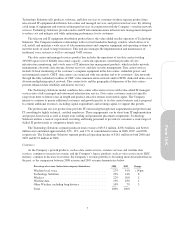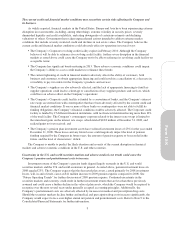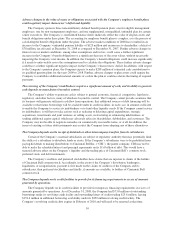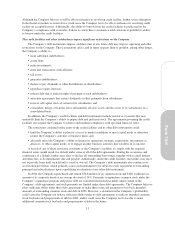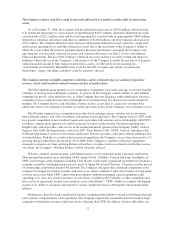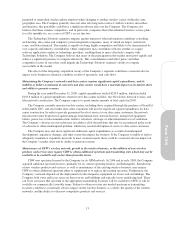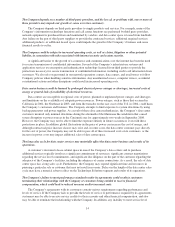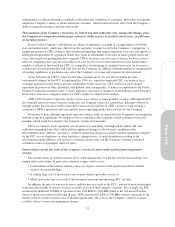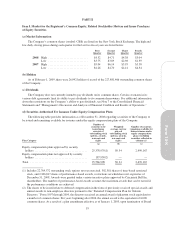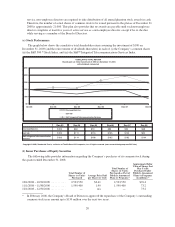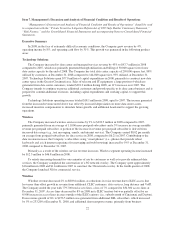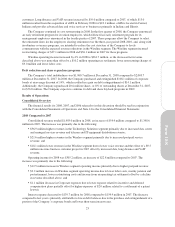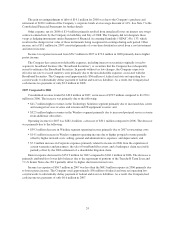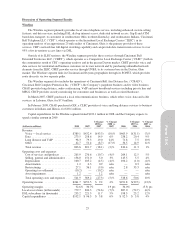Cincinnati Bell 2008 Annual Report Download - page 115
Download and view the complete annual report
Please find page 115 of the 2008 Cincinnati Bell annual report below. You can navigate through the pages in the report by either clicking on the pages listed below, or by using the keyword search tool below to find specific information within the annual report.
commitments or other performance standards could reduce the confidence of customers and could consequently
impair the Company’s ability to obtain and retain customers, which would adversely affect both the Company’s
ability to generate revenues and operating results.
The regulation of the Company’s businesses by federal and state authorities may, among other things, place
the Company at a competitive disadvantage, restrict its ability to price its products and services, and threaten
its operating licenses.
Several of the Company’s subsidiaries are subject to regulatory oversight of varying degrees at both the
state and federal levels, which may differ from the regulatory scrutiny faced by the Company’s competitors. A
significant portion of CBT revenue is derived from pricing plans that require regulatory overview and approval.
Different interpretations by regulatory bodies may result in adjustments to revenue in future periods. In recent
years, these regulated pricing plans have required CBT to decrease or fix the rates it charges for some services
while its competition has typically been able to set rates for its services with limited restriction. In the future,
regulatory initiatives that would put CBT at a competitive disadvantage or mandate lower rates for its services
could result in lower profitability and cash flow for the Company. In addition, different regulatory interpretations
of existing regulations or guidelines may affect the Company’s revenues and expenses in future periods.
At the federal level, CBT is subject to the Telecommunications Act of 1996, including the rules
subsequently adopted by the FCC to implement the 1996 Act, which has impacted CBT’s in-territory local
exchange operations in the form of greater competition. At the state level, CBT conducts local exchange
operations in portions of Ohio, Kentucky, and Indiana, and, consequently, is subject to regulation by the Public
Utilities Commissions in those states. Various regulatory decisions or initiatives at the federal or state level may
from time to time have a negative impact on CBT’s ability to compete in its markets.
CBW’s FCC licenses to provide wireless services are subject to renewal and revocation. Although the FCC
has routinely renewed wireless licenses in the past, the Company cannot be assured that challenges will not be
brought against those licenses in the future. Revocation or non-renewal of CBW’s licenses could result in a
cessation of CBW’s operations and consequently lower operating results and cash flow for the Company.
From time to time, different regulatory agencies conduct audits to ensure that the Company is in compliance
with the respective regulations. If found not to be in compliance, the Company could be subject to fines and
penalties which could be material to the Company’s financial statements.
There are currently many regulatory actions under way and being contemplated by federal and state
authorities regarding issues that could result in significant changes to the business conditions in the
telecommunications industry. Assurances cannot be given that changes in current or future regulations adopted
by the FCC or state regulators, or other legislative, administrative, or judicial initiatives relating to the
telecommunications industry, will not have a material adverse effect on the Company’s business, financial
condition, results of operations, and cash flows.
Future declines in the fair value of the Company’s wireless licenses could result in future impairment
charges.
The market values of wireless licenses have varied dramatically over the last several years and may vary
significantly in the future. In particular, valuation swings could occur if:
•Consolidation in the wireless industry allows or requires carriers to sell significant portions of their
wireless spectrum holdings;
•A sudden large sale of spectrum by one or more wireless providers occurs; or
•Market prices decline as a result of the sale prices in recent and upcoming FCC auctions.
In addition, the price of wireless licenses could decline as a result of the FCC’s pursuit of policies designed
to increase the number of wireless licenses available in each of the Company’s markets. For example, the FCC
auctioned an additional 90 MHz of spectrum in the 1700 MHz to 2100 MHz band in the Advanced Wireless
Services spectrum auction in 2006 and, in early 2008, auctioned 62 MHz of 700 MHz wireless spectrum. If the
market value of wireless licenses were to decline significantly, the value of the Company’s wireless licenses
could be subject to non-cash impairment charges.
15
Form 10-K




